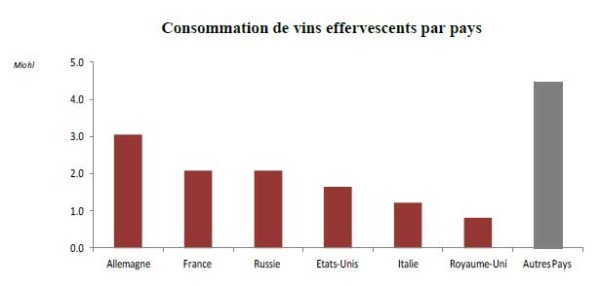The world production and consumption of sparkling wine has increased significantly in recent years, according to a recent report by the OIV (International Organisation of Vine and Wine). 17.6 million hectolitres of sparkling wine was produced in 2013. Over ten years the production has increased with 40%. The consumption is also changing: today we drink sparkling wine more regularly, not only on festive occasions
Sparkling wine has become more and more popular. In some market segments and on some markets, it has even become the trendy thing to drink. Sweden, for example, is a market where champagne in particular, but also other sparkling wines, have seen a boom. Let’s take a look at the global market, production and consumption, of sparkling wine.
This article is based on a recent report by the OIV, Organisation International de la Vigne et du Vin. “Sparkling wine” includes all types of bubbly: fermented in bottle (like e.g. champagne), fermented in tank (like e.g. prosecco), and also still wine to which carbon dioxide (CO2) has been added (let’s not mention them).
World sparkling wine production: up
17.6 million hectolitres of sparkling wine was produced in 2013. This is almost 7% of all wine production.
Production, as well as share of total production, has increased steadily since the early 2000s. In 2002 (eleven years earlier) the total production was 9 million hectolitres and sparkling wine made up not even 4% of world wine production.

The biggest producers of sparkling wine are:
- France, 3.5 million hl, 15% of world total production of sparkling wine
- Italy, 3.2 Mhl
- Germany, 2.6 Mhl
- Spain
- Russia
There top five countries taken together make almost three quarter of all sparkling wine: 74%.
France, Italy and Spain are no surprises since they are also the world’s top wine producing countries. More of a surprise are Germany in third place and Russia in fifth. But both Germans and Russians have a traditional faiblesse for bubbly wine. Who has, for instance, not heard about the Russians love for champagne, in particular the sweet version? So it is perhaps not a surprise that much of it is produced at home.
But both France, Italy, Spain and Germany are losing share in world production. Ten years ago their share was bigger.
Russia, on the other hand, as well as “rest of the world” is increasing their share of world sparkling wine production. Russia today makes almost 1.8 Mhl. In 2002 they barely made 0.8 Mhl.
One remarkable number is that 31%, very close to one third, of all wine made in Germany is sparkling.
Just to put these numbers in a little bit of a perspective, some ~320 million bottles of champagne made each year, or 2.3-2.5 million hectolitres. This is roughly two thirds of the total sparkling production in France or 15% of the world total.
World sparkling wine consumption: up
The OIV notes that the world is moving to a more regular consumption of sparkling wine. Bubbly is drunk not only at the end of the year but more and more at other festive occasions and just simply as aperitif.
That certainly seems to be true in France. It is almost rare to be invited to have some other aperitif – pre-dinner drink – than sparkling wine when invited for dinner in France. And since it is in France it is almost invariably champagne.
Global consumption of sparkling wine has increased with 30% over the last ten years. Consumption of still wine has also increased but only with 4%.
The total global consumption of sparkling wine in 2013 reached 15.4 million hectolitres.

There is an obvious gap between the production of sparkling wine and the consumption: 2.2 Mhl more was made in 2013 than what is drunk. I am not sure what the reason is for this. Perhaps it is that some sparkling wine is sold only after being aged for one or more years in the cellar (for example the case with champagne) or if perhaps someone is stockpiling it….
So, who is drinking all this sparkling wine? Perhaps not quite who you think.
A big clue is in the ranking of the producers. Here are the top six markets for sparkling wine:
- Germany, 3.1 Mhl
- France, 2.1 Mhl
- Russia, almost 2 Mhl
- United States
- Italy
- United Kingdom

It is curious to note that the consumption fluctuates significantly in some countries over the period 2003-2013. See for example France that drank 1.5 Mhl in 2003 and 3.2 Mhl in 2004.

International trade in sparkling wine
Exports (and imports) of sparkling wine has increased even more dramatically: since 2000 exports of sparkling wine has more than doubled, from 3.2 Mhl to 8.7 Mhl in 2013. In other words almost exactly 50% of all sparkling wine produced is today sold on export. Counted in volume.
If instead we count in value the evolution has been very similar, with one big exception. The financial crisis in 2008, whose effects were mainly seen (in this case) in 2009 made the value of export shrink dramatically in 2009. Obviously, in 2009, the World was no longer prepared to pay the high prices that it was paying before the financial crisis in 2008. However, since 2009 prices seem to be increasing more rapidly than volumes, so the value of the exports is catching up. The world is again getting ready to pay dearly for bubbly.
It is also interesting to compare volume and value compared to world total wine exports:
- Sparkling wine represents 9% of the world total exports in volume
- Sparkling wine represents 18% of the world total exports in value
The region most affected by the crisis in 2008-2009 was no doubt Champagne, where there were perhaps also the biggest margins to squeeze down prices. Champagne has a unique position on the world market of sparkling wines thanks to its comparatively high prices. This is also well illustrated by comparing France’s share of world exports in volume and in value.

French exports are only 18% of world total measured in volume, but are 53% when measured in value. There must be some pretty expensive bottles being shipped.
The world market numbers and illustrations come from a report from the OIV: Le marché des vins effervescents, published in the autumn of 2014.










2 Responses